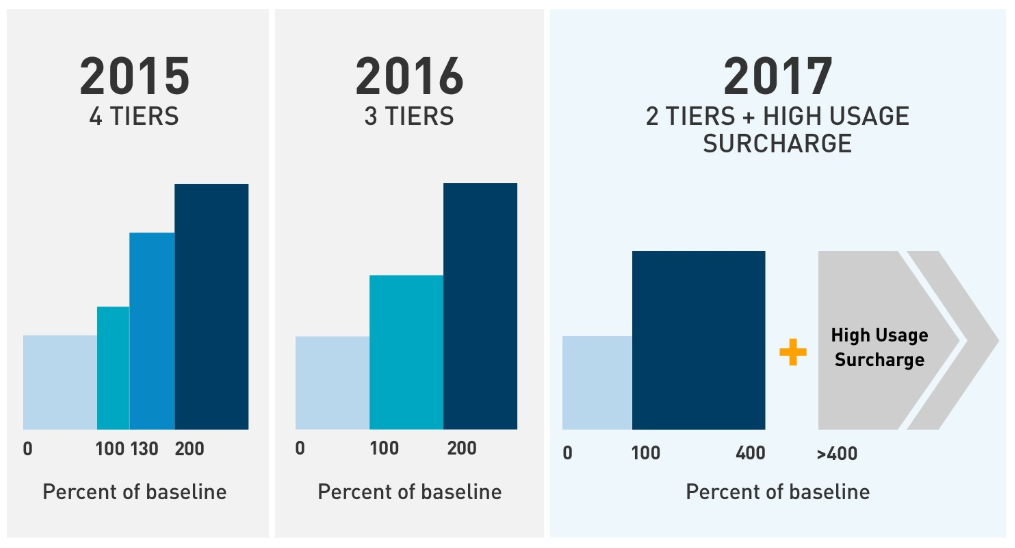PG&E Raised Prices 4% Annually on Average to Discourage High Users
California’s largest utility, Pacific Gas and Electric Co (PG&E), is making strides towards limiting energy use, simplifying rate plans, and promoting clean energy.
Unfortunately, if you’re a residential PG&E customer, these strides are leading to higher utility bills if you don’t make an effort to conserve.
Here’s a look into how PG&E has altered their electricity rate structures, and how this compares to the cost of adding solar panels to your home.
A Brief History of PG&E’s Electricity Rates
In 2015, PG&E made significant changes to their tiered rate plan, which most customers are registered for. These changes stem from their desire to align their rates more closely with the costs of providing electricity.
2001-2015: The Energy Crisis
Since the California energy crisis of 2001, where energy supply was limited and rates were skyrocketing, PG&E could only increase the top two tiers in their 4-tiered plan. This had resulted in extreme disparities between the tiers. PG&E thus decided to create a roadmap to reduce the number of tiers from 4 to 2 and to shrink the price difference between the tiers.
They also doubled the minimum amount that residents will be charged each month, which normally only applies to residents who use very little energy or have solar.
2016: Time Of Use Introduced
Starting in 2016, the utility giant released a new Time Of Use (TOU) rate plan. This plan charges customers less for energy used during times of low demand and when renewable energy, such as solar power, is abundant. They charge more for the energy used during hours with high demand and lower supply.
This plan also charges more for energy used during the summer, rather than in the winter. Peak demand hours are typically 3pm-9pm on weekdays.
2017: 2 Tiers & High Use Surcharge
In 2017, the tiered rate plan was now at 2 tiers, with a costly usage surcharge. This surcharge encourages energy conservation by charging customers a high rate for energy usage over 400% of their baseline energy. These surcharges will be gradually increased in 2018, 2019 and beyond.

PG&E’s Tier Structure Changes from 2015-2017 (source)
2018 and Beyond
Starting in 2018, 150,000 PG&E customers were transferred to the Time Of Use rate structure. The current TOU rate structure uses a combination of both baseline energy and a time of use rate distinction. So, you’re charged for your electricity based on how much you use and when you use it.
Table 1 shows the electricity rate structure for PG&E residential, Time Of Use customers for September 2018.
Table 1: PG&E Residential, Time Of Use rate structure for September 2018-Present
| $/kWh | 0-100% of Baseline Usage | Over 100% of Baseline | |
| Summer | On-Peak | 0.375 | 0.462 |
| Off-Peak | 0.182 | 0.270 | |
| Winter | On-Peak | 0.204 | 0.291 |
| Off-Peak | 0.187 | 0.274 |
How do PG&E’s rate changes affect me?
The new tiered and TOU rate structures are designed to only increase prices for high energy consumption customers. Mid to high usage customers will see increases in their bill, making conserving energy financially and environmentally attractive to PG&E residents.
After all these changes, your current rate structure may not be the best option and you could be saving money by switching plans. Luckily, PG&E allows customers to change their rate structure online once a year.
Avoiding Rate Hikes in PG&E By Going Solar
Are you experiencing higher PG&E bills? A rooftop solar array could be a great option to reduce that monthly “rent” expense. Here’s how.
The Levelized Cost of Energy (LCOE) for solar represents the unit cost of solar generation over the lifetime of the PV system. Fortunately, solar LCOE is much lower than other non-renewable sources of energy.
The average per kilowatt hour rate for PG&E residents has been increasing by about 4% each year for an increase of 44% since 2008, while U.S. residential solar costs have been decreasing by an average of 12% every year.
Check this video to learn more about Kilowatt-hour.
Graph adopted from IRENA and PGE sources
Even when prices are high during peak summer hours, a solar owner will be generating their own electric power and avoiding contributing to their PG&E Baseline Energy. Solar owners are dodging these price increases and surcharges by using the energy their solar generates instead of taking energy from PG&E, particularly when they pair their solar array with a home battery system.
Quick Tips for Going Solar in PG&E Area
Here are a few quick things to keep in mind if you’re thinking about going solar as a PG&E customer:
- Understand Net Energy Metering 2.0 – This will be the payment structure you’ll adopt when you switch to solar. Read our summary of NEM 2.0 for PG&E and check this video to understand NEM 2.0
- Review available solar incentives – Our summary of solar incentives in California will give help you understand what you can expect to pay for your own solar array. You can also use our calculator for an instant look at solar for your home, based on your current monthly bill.
- Compare quotes from multiple solar companies – Local companies will have better customer service and pricing than national providers. Use our online comparison platform to easily gather quotes from multiple providers in your area.








